Carbon Dioxide Activation and Hydrogenation into Value-Added C1 Chemicals over Metal Hydride Catalysts
Abstract
1. Introduction
 CH4(g) + 2 H2O(g) ΔG298K = −113.5 kJ/mol
CH4(g) + 2 H2O(g) ΔG298K = −113.5 kJ/molΔH298K = −164.7 kJ/mol
 CO(g) + H2O(g) ΔG298K = +28.6 kJ/mol
CO(g) + H2O(g) ΔG298K = +28.6 kJ/molΔH298K = +41.2 kJ/mol
 HCOOH(l) ∆G298K = +32.9 KJ/mol
HCOOH(l) ∆G298K = +32.9 KJ/mol∆H298K = −31.2 KJ/mol
 HCOO−(aq) + NH4+(aq) ∆G298K = −9.5 KJ/mol
HCOO−(aq) + NH4+(aq) ∆G298K = −9.5 KJ/mol∆H298K = −83.4 KJ/mol
 CH3OH(l) + H2O(g) ΔG298K = 3.5 kJ/mol
CH3OH(l) + H2O(g) ΔG298K = 3.5 kJ/mol∆H298K = −49.5 KJ/mol
2. Metal Hydrides
2.1. Basic Properties of Metal Hydrides
2.2. CO2 Hydrogenation over Metal Hydrides
2.2.1. Synthesis of CH4 over Metal Hydrides
2.2.2. Synthesis of Formic Acid and Methanol over Metal Hydrides
 CO2 + H2
CO2 + H2
 Ca(OH)2 + CaCO3 + 7 H2
Ca(OH)2 + CaCO3 + 7 H2
2.3. Effect of H2 Dissociation and Formation of Metal Hydrides over Catalysts During CO2 Hydrogenation to C1 Chemicals
2.4. Oxyhydrides for the CO2 Hydrogenation
3. Hydrogenation of CO2 over Homogeneous Transition Metal Hydrides Catalysts
4. Conclusions
5. Future Outlook and Perspective
Author Contributions
Funding
Data Availability Statement
Acknowledgments
Conflicts of Interest
Abbreviations
| MH | Metal hydrides |
| GHG | Greenhouse gas |
| INS | Inelastic neutron scattering spectroscopy |
| TOS | Time on stream |
| WHSV | Weight hourly space velocity |
| AP-XPS | Ambient-pressure X-ray photoelectron spectroscopy |
| XRD | X-ray spectroscopy |
| IR | Infrared spectroscopy |
| DFT | Density functional theory |
References
- Khan, A.A.; Tahir, M. Recent advancements in engineering approach towards design of photo-reactors for selective photocatalytic CO2 reduction to renewable fuels. J. CO2 Util. 2019, 29, 205–239. [Google Scholar] [CrossRef]
- Zhong, J.; Yang, X.; Wu, Z.; Liang, B.; Huang, Y.; Zhang, T. State of the art and perspectives in heterogeneous catalysis of CO2 hydrogenation to methanol. Chem. Soc. Rev. 2020, 49, 1385–1413. [Google Scholar] [CrossRef]
- Wei, L.; Yu, C.; Zhang, Q.; Liu, H.; Wang, Y. TiO2-based heterojunction photocatalysts for photocatalytic reduction of CO2 into solar fuels. J. Mater. Chem. A 2018, 6, 22411–22436. [Google Scholar] [CrossRef]
- Li, K.; Teng, C.; Wang, S.; Min, Q. Recent Advances in TiO2-Based Heterojunctions for Photocatalytic CO2 Reduction with Water Oxidation: A Review. Front. Chem. 2021, 9, 637501. [Google Scholar] [CrossRef]
- Setia, D.; Roithová, J. Trends in the hydricities of iron, cobalt, and nickel complexes and the metal-hydride reactivities with CO2. Int. J. Mass Spectrom. 2024, 504, 117310. [Google Scholar] [CrossRef]
- Younas, M.; Loong Kong, L.; Bashir, M.J.K.; Nadeem, H.; Shehzad, A.; Sethupathi, S. Recent Advancements, Fundamental Challenges, and Opportunities in Catalytic Methanation of CO2. Energy Fuels 2016, 30, 8815–8831. [Google Scholar] [CrossRef]
- Frei, M.S.; Mondelli, C.; García-Muelas, R.; Kley, K.S.; Puértolas, B.; López, N.; Safonova, O.V.; Stewart, J.A.; Ferré, D.C.; Peréz-Ramírez, J. Atomic-scale engineering of indium oxide promotion by palladium for methanol production via CO2 hydrogenation. Nat. Commun. 2019, 10, 3377. [Google Scholar] [CrossRef]
- Lv, X.; Lu, G.; Wang, Z.Q.; Xu, Z.N.; Guo, G.C. Computational Evidence for Lewis Base-Promoted CO2 Hydrogenation to Formic Acid on Gold Surfaces. ACS Catal. 2017, 7, 4519–4526. [Google Scholar] [CrossRef]
- Reutemann, W.; Kieczka, H. Formic acid. Ullmann’s Encycl. Ind. Chem. 2012, 16, 13–31. [Google Scholar] [CrossRef]
- Pérez-Fortes, M.; Schöneberger, J.C.; Boulamanti, A.; Tzimas, E. Methanol synthesis using captured CO2 as raw material: Techno-economic and environmental assessment. Appl. Energy 2016, 161, 718–732. [Google Scholar] [CrossRef]
- Cordero-Lanzac, T.; Ramirez, A.; Navajas, A.; Gevers, L.; Brunialti, S.; Gandía, L.M.; Aguayo, A.T.; Sarathy, S.M.; Gascon, J. A techno-economic and life cycle assessment for the production of green methanol from CO2: Catalyst and process bottlenecks. J. Energy Chem. 2022, 68, 255–266. [Google Scholar] [CrossRef]
- Iribarren, D.; Calvo-Serrano, R.; Martín-Gamboa, M.; Galán-Martín, A.; Guillén-Gosálbez, G. Social life cycle assessment of green methanol and benchmarking against conventional fossil methanol. Sci. Total Environ. 2022, 824, 153840. [Google Scholar] [CrossRef]
- Zhang, X.; Zhang, G.; Song, C.; Guo, X. Catalytic Conversion of Carbon Dioxide to Methanol: Current Status and Future Perspective. Front. Energy Res. 2021, 8, 621119. [Google Scholar] [CrossRef]
- Cheng, D.; Negreiros, F.R.; Aprà, E.; Fortunelli, A. Computational approaches to the chemical conversion of carbon dioxide. ChemSusChem. 2013, 6, 944–965. [Google Scholar] [CrossRef]
- Lykaki, M.; Mandela, E.; Varvoutis, G.; Lampropoulos, A.; Marnellos, G.E.; Konsolakis, M. State-of-the-art thermocatalytic systems for CH4 and CO production via CO2 hydrogenation: Critical comparison, mechanistic considerations and structure-performance insights. Discov. Chem. Eng. 2024, 4, 11. [Google Scholar] [CrossRef]
- Wang, M.; Luo, L.; Wang, C.; Du, J.; Li, H.; Zeng, J. Heterogeneous Catalysts toward CO2 Hydrogenation for Sustainable Carbon Cycle. Accounts Mater. Res. 2022, 3, 565–571. [Google Scholar] [CrossRef]
- Álvarez, A.; Bansode, A.; Urakawa, A.; Bavykina, A.V.; Wezendonk, T.A.; Makkee, M.; Gascon, J.; Kapteijn, F. Challenges in the Greener Production of Formates/Formic Acid, Methanol, and DME by Heterogeneously Catalyzed CO2 Hydrogenation Processes. Chem. Rev. 2017, 117, 9804–9838. [Google Scholar] [CrossRef]
- Jacquemin, M.; Beuls, A.; Ruiz, P. Catalytic production of methane from CO2 and H2 at low temperature: Insight on the reaction mechanism. Catal. Today 2010, 157, 462–466. [Google Scholar] [CrossRef]
- Maru, M.S.; Ram, S.; Shukla, R.S.; Khan, N.H. Ruthenium-hydrotalcite (Ru-HT) as an effective heterogeneous catalyst for the selective hydrogenation of CO2 to formic acid. Mol. Catal. 2018, 446, 23–30. [Google Scholar] [CrossRef]
- Shen, C.; Sun, K.; Zou, R.; Wu, Q.; Mei, D.; Liu, C.J. CO2 Hydrogenation to Methanol on Indium Oxide-Supported Rhenium Catalysts: The Effects of Size. ACS Catal. 2022, 12, 12658–12669. [Google Scholar] [CrossRef]
- Monene, T.J.; Cele, M.N. The activities of selected metals and supports for CO2 hydrogenation to methanol: A review. Appl. Catal. O Open 2024, 197, 207019. [Google Scholar] [CrossRef]
- Wang, J.; Zhang, G.; Zhu, J.; Zhang, X.; Ding, F.; Zhang, A.; Guo, X.; Song, C. CO2 Hydrogenation to Methanol over In2O3-Based Catalysts: From Mechanism to Catalyst Development. ACS Catal. 2021, 11, 1406–1423. [Google Scholar] [CrossRef]
- Grinter, D.C.; Graciani, J.; Palomino, R.M.; Xu, F.; Waluyo, I.; Sanz, J.F.; Senanayake, S.D.; Rodriguez, J.A. Adsorption and activation of CO2 on Pt/CeOx/TiO2(110): Role of the Pt-CeOx interface. Surf. Sci. 2021, 710, 121852. [Google Scholar] [CrossRef]
- Chinchen, G.C.; Spencer, M.S.; Waugh, K.C.; Whan, D.A. Promotion of methanol synthesis and the water-gas shift reactions by adsorbed oxygen on supported copper catalysts. J. Chem. Soc. Faraday Trans. 1 1987, 83, 2193–2212. [Google Scholar] [CrossRef]
- Eren, B.; Weatherup, R.S.; Liakakos, N.; Somorjai, G.A.; Salmeron, M. Dissociative Carbon Dioxide Adsorption and Morphological Changes on Cu(100) and Cu(111) at Ambient Pressures. J. Am. Chem. Soc. 2016, 138, 8207–8211. [Google Scholar] [CrossRef]
- Su, H.; Ye, Y.; Lee, K.J.; Zeng, J.; Mun, B.S.; Crumlin, E.J. Probing the surface chemistry for reverse water gas shift reaction on Pt(111) using ambient pressure X-ray photoelectron spectroscopy. J. Catal. 2020, 391, 123–131. [Google Scholar] [CrossRef]
- Sheffield, J.; Martin, K.B. Alternative Fuels and Advanced Vehicle Technologies for Improved Environmental Performance; Woodhead Publishing Ltd.: Sawston, UK, 2014; pp. 117–135. [Google Scholar]
- Gay-Lussac, J.L.; Thenard, L.J. Recherches physico-chimiques. Paris 1811, 2, 1–57. [Google Scholar]
- Hautefeuille, P.; Troost, L. Alliages de l’hydrogèke avec les métaux alcalins. Ann. Chim. Phys. 1874, 2, 273. [Google Scholar]
- Maeno, Z.; Yasumura, S.; Wu, X.; Huang, M.; Liu, C.; Toyao, T.; Shimizu, K. Isolated Indium Hydrides in CHA Zeolites: Speciation and Catalysis for Nonoxidative Dehydrogenation of Ethane. J. Am. Chem. Soc. 2020, 142, 4820–4832. [Google Scholar] [CrossRef]
- Yu, H.; Li, X.; Zheng, J. Beyond Hydrogen Storage: Metal Hydrides for Catalysis. ACS Catal. 2024, 14, 3139–3157. [Google Scholar] [CrossRef]
- Wang, Q.; Guo, J.; Chen, P. Complex transition metal hydrides for heterogeneous catalysis. Chem Catal. 2023, 3, 100524. [Google Scholar] [CrossRef]
- Schneemann, A.; White, J.L.; Kang, S.Y.; Jeong, S.; Wan, L.F.; Cho, E.S.; Heo, T.W.; Prendergast, D.; Urban, J.J.; Wood, B.C.; et al. Nanostructured Metal Hydrides for Hydrogen Storage. Chem. Rev. 2018, 118, 10775. [Google Scholar] [CrossRef] [PubMed]
- Wietelmann, U.; Felderhoff, M.; Rittmeyer, P. Hydrides. In Ullmann’s Encyclopedia of Industrial Chemistry; Wiley: Berlin, Germany, 2016; pp. 1–36. [Google Scholar]
- Luo, Y.; Wang, Q.; Li, J.; Xu, F.; Sun, L.; Zou, Y.; Chu, H.; Li, B.; Zhang, K. Enhanced hydrogen storage/sensing of metal hydrides by nanomodification. Mater. Today Nano 2020, 9, 100071. [Google Scholar] [CrossRef]
- Dekura, S.; Kobayashi, H.; Kusada, K.; Kitagawa, H. Hydrogen in Palladium and Storage Properties of Related Nanomaterials: Size, Shape, Alloying, and Metal–Organic Framework Coating Effects. Phys. Chem. Chem. Phys. 2019, 20, 1158–1176. [Google Scholar] [CrossRef]
- Copéret, C. C-H bond activation and organometallic intermediates on isolated metal centers on oxide surfaces. Chem. Rev. 2010, 110, 656–680. [Google Scholar] [CrossRef] [PubMed]
- Copéret, C.; Estes, D.P.; Larmier, K.; Searles, K. Isolated Surface Hydrides: Formation, Structure, and Reactivity. Chem. Rev. 2016, 116, 8463–8505. [Google Scholar] [CrossRef]
- Serykh, A.I. Low-Dimensional Indium Oxo-Species on the Surface of In2O3/Al2O3 Catalytic Material: The Sites of Dissociative Adsorption of Hydrogen. J. Phys. Chem. C 2016, 120, 21436–21440. [Google Scholar] [CrossRef]
- Miyazaki, M.; Ogasawara, K.; Nakao, T.; Sasase, M.; Kitano, M.; Hosono, H. Hexagonal BaTiO(3-x)Hx Oxyhydride as a Water-Durable Catalyst Support for Chemoselective Hydrogenation. J. Am. Chem. Soc. 2022, 144, 6453–6464. [Google Scholar] [CrossRef]
- Waldie, K.M.; Ostericher, A.L.; Reineke, M.H.; Sasayama, A.F.; Kubiak, C.P. Hydricity of Transition-Metal Hydrides: Thermodynamic Considerations for CO2 Reduction. ACS Catal. 2018, 8, 1313–1324. [Google Scholar] [CrossRef]
- Niu, Y.; Borsodi, J.; Wootsch, A.; Révay, Z.; Hävecker, M.; Knop-Gericke, A.; Jackson, S.D.; Schlögl, R. Visualizing Formation of Intermetallic PdZn in a Palladium/Zinc Oxide Catalyst: Interfacial Fertilization by PdHx. Angew. Chemie—Int. Ed. 2019, 58, 4232–4237. [Google Scholar] [CrossRef] [PubMed]
- Teschner, D.; Borsodi, J.; Wootsch, A.; Révay, Z.; Hävecker, M.; Knop-Gericke, A.; Jackson, S.D.; Schlögl, R. The Roles of Subsurface Carbon and Hydrogen in Palladium-Catalyzed Alkyne Hydrogenation. Science 2008, 320, 86–89. [Google Scholar] [CrossRef]
- Fovanna, T.; Nachtegaal, M.; Clark, A.H.; Kröcher, O.; Ferri, D. Preparation, Quantification, and Reaction of Pd Hydrides on Pd/Al2O3 in Liquid Environment. ACS Catal. 2023, 13, 3323–3332. [Google Scholar] [CrossRef]
- Chang, F.; Tezsevin, I.; de Rijk, J.W.; Meeldijk, J.D.; Hofmann, J.P.; Er, S.; Ngene, P.; de Jongh, P.E. Potassium hydride-intercalated graphite as an efficient heterogeneous catalyst for ammonia synthesis. Nat. Catal. 2022, 5, 222–230. [Google Scholar] [CrossRef]
- Chang, F.; Guan, Y.; Chang, X.; Guo, J.; Wang, P.; Gao, W.; Wu, G.; Zheng, J.; Li, X.; Chen, P. Alkali and Alkaline Earth Hydrides-Driven N2 Activation and Transformation over Mn Nitride Catalyst. J. Am. Chem. Soc. 2018, 140, 14799–14806. [Google Scholar] [CrossRef]
- Wang, P.; Chang, F.; Gao, W.; Guo, J.; Wu, G.; He, T.; Chen, P. Breaking scaling relations to achieve low-temperature ammonia synthesis through LiH-mediated nitrogen transfer and hydrogenation. Nat. Chem. 2017, 9, 64–70. [Google Scholar] [CrossRef] [PubMed]
- Tang, Y.; Kobayashi, Y.; Masuda, N.; Uchida, Y.; Okamoto, H.; Kageyama, T.; Hosokawa, S.; Loyer, F.; Mitsuhara, K.; Yamanaka, K.; et al. Metal-Dependent Support Effects of Oxyhydride-Supported Ru, Fe, Co Catalysts for Ammonia Synthesis. Adv. Energy Mater. 2018, 8, 1801772. [Google Scholar] [CrossRef]
- Kitano, M.; Inoue, Y.; Ishikawa, H.; Yamagata, K.; Nakao, T.; Tada, T.; Matsuishi, S.; Yokoyama, T.; Hara, M.; Hosono, H. Essential role of hydride ion in ruthenium-based ammonia synthesis catalysts. Chem. Sci. 2016, 7, 4036–4043. [Google Scholar] [CrossRef]
- Chen, H.; Liu, P.; Li, J.; Wang, Y.; She, C.; Liu, J.; Zhang, L.; Yang, Q.; Zhou, S.; Feng, X. MgH2/CuxO Hydrogen Storage Composite with Defect-Rich Surfaces for Carbon Dioxide Hydrogenation. ACS Appl. Mater. Interfaces 2019, 11, 31009–31017. [Google Scholar] [CrossRef]
- Feng, X.; Jiang, L.; Li, Z.; Wang, S.; Ye, J.; Wu, Y.; Yuan, B. Boosting the hydrogenation activity of dibenzyltoluene catalyzed by Mg-based metal hydrides. Int. J. Hydrogen Energy 2022, 47, 23994–24003. [Google Scholar] [CrossRef]
- Lelis, M.; Varnagiris, S.; Urbonavicius, M.; Zakarauskas, K. Investigation of catalyst development from Mg2NiH4 hydride and its application for the CO2 methanation reaction. Coatings 2020, 10, 1178. [Google Scholar] [CrossRef]
- Amica, G.; Gennari, F.C. Synergistic effect of MgH2 doping with Ni and carbon nanotubes on thermochemical CO2 recycling process for CH4-H2 mixtures production. Int. J. Hydrogen Energy 2022, 47, 428–442. [Google Scholar] [CrossRef]
- Chen, H.; Liu, P.; Liu, J.; Feng, X.; Zhou, S. Mechanochemical in-situ incorporation of Ni on MgO/MgH2 surface for the selective O-/C-terminal catalytic hydrogenation of CO2 to CH4. J. Catal. 2021, 394, 397–405. [Google Scholar] [CrossRef]
- Grasso, M.L.; Puszkiel, J.; Gennari, F.C.; Santoru, A.; Dornheim, M.; Pistidda, C. CO2 reactivity with Mg2NiH4 synthesized by in situ monitoring of mechanical milling. Phys. Chem. Chem. Phys. 2020, 22, 1944–1952. [Google Scholar] [CrossRef] [PubMed]
- Zhong, D.; Ouyang, L.; Liu, J.; Wang, H. Metallic Ni nanocatalyst in situ formed from LaNi5H5 toward efficient CO2 methanation. Int. J. Hydrogen Energy 2019, 44, 29068–29074. [Google Scholar] [CrossRef]
- Chen, H.; Ma, N.; Cheng, C.; Zhang, H.; Yuan, W.; Liu, P. Hydrogen activation on aluminium-doped magnesium hydride surface for methanation of carbon dioxide. Appl. Surf. Sci. 2020, 515, 146038. [Google Scholar] [CrossRef]
- Amica, G.; Azcona, R.; Aparicio, S.; Gennari, F.C. Catalysis effect on CO2 methanation using MgH2 as a portable hydrogen medium. Phys. Chem. Chem. Phys. 2020, 22, 14720–14730. [Google Scholar] [CrossRef]
- Grasso, M.L.; Puszkiel, J.; Albanesi, F.; Dornheim, L.M.; Pistidda, C.; Gennari, F.C. CO2 reutilization for methane production via a catalytic process promoted by hydrides. Phys. Chem. Chem. Phys. 2019, 21, 19825–19834. [Google Scholar] [CrossRef]
- Zhao, J.; Wei, Y.F.; Cai, Y.L.; Wang, L.Z.; Xie, J.; Teng, Y.L.; Zhu, W.; Shen, M.; Dong, B.X. Highly Selective and Efficient Reduction of CO2 to Methane by Activated Alkaline Earth Metal Hydrides without a Catalyst. ACS Sustain. Chem. Eng. 2019, 7, 4831–4841. [Google Scholar] [CrossRef]
- Kato, S.; Matam, S.K.; Kerger, P.; Bernard, L.; Battaglia, C.; Vogel, D.; Rohwerder, M.; Zuttel, A. The Origin of the Catalytic Activity of a Metal Hydride in CO2 Reduction. Angew. Chemie—Int. Ed. 2016, 55, 6028–6032. [Google Scholar] [CrossRef]
- Kato, S.; Borgschulte, A.; Ferri, D.; Bielmann, M.; Crivello, J.C.; Wiedenmann, D.; Parlinska-Wojtan, M.; Rossbach, P.; Lu, Y.; Remhof, A.; et al. CO2 hydrogenation on a metal hydride surface. Phys. Chem. Chem. Phys. 2012, 14, 5518–5526. [Google Scholar] [CrossRef]
- Dong, B.X.; Wang, L.Z.; Song, L.; Zhao, J.; Teng, Y.L. Thermochemical Reduction of Carbon Dioxide with Alkali Metal Hydrides, Producing Methane and Hydrogen Fuels at Moderate Temperatures. Energy Fuels 2016, 30, 6620–6625. [Google Scholar] [CrossRef]
- Zhao, J.; Teng, Y.L.; Dong, B.X. Thermal Reduction of CO2 with Activated Alkali Metal Aluminum Hydrides for Selective Methanation. Energy Fuels 2020, 34, 11210–11218. [Google Scholar] [CrossRef]
- Nilwanna, K.; Sittiwong, J.; Boekfa, B.; Treesukol, P.; Boonya-udtayan, S.; Probst, M.; Maihom, T.; Limtrakul, J. Aluminum-based metal-organic framework support metal(II)-hydride as catalyst for the hydrogenation of carbon dioxide to formic acid: A computational study. Mol. Catal. 2023, 541, 113116. [Google Scholar] [CrossRef]
- Zhang, X.; Liu, G.; Meiwes-Broer, K.H.; Gantefor, G.; Bowen, K. CO2 Activation and Hydrogenation by PtHn- Cluster Anions. Angew. Chemie—Int. Ed. 2016, 55, 9644–9647. [Google Scholar] [CrossRef] [PubMed]
- Habib, M.; Sarkar, R.; Biswas, S.; Pramanik, A.; Sarkar, P.; Pal, S. Unambiguous hydrogenation of CO2 by coinage-metal hydride anions: An intuitive idea based on in silico experiments. Phys. Chem. Chem. Phys. 2019, 21, 7483–7490. [Google Scholar] [CrossRef] [PubMed]
- Kadeer, K.; Li, X.; Zheng, J. Hydrogen generation by coupling methanol steam reforming with metal hydride hydrolysis. Chem. Commun. 2023, 59, 5443–5446. [Google Scholar] [CrossRef]
- Kim, J.; Lim, H.; Tian, Y.; Piliai, L.; Hunt, A.; Waluyo, I.; Senanayake, S.D.; Rodriguez, J.A. The Surface Chemistry of Methanol on Pd(111) and H-Pd(111) Surfaces: C-O Bond Cleavage and the Effects of Metal Hydride Formation. J. Phys. Chem. Lett. 2024, 15, 6209–6215. [Google Scholar] [CrossRef]
- Rusman, N.A.A.; Dahari, M. A review on the current progress of metal hydrides material for solid-state hydrogen storage applications. Int. J. Hydrogen Energy 2016, 41, 12108–12126. [Google Scholar] [CrossRef]
- Akamaru, S.; Hara, M.; Matsuyama, M. Alloying effects on the hydrogen-storage capability of Pd-TM-H (TM = Cu, Au, Pt, Ir) systems. J. Alloys Compd. 2014, 614, 238–243. [Google Scholar] [CrossRef]
- Yao, J.; Wang, B.; Chen, H.; Han, Z.; Wu, Y.; Cai, Z.; Manggada, G.W.; Elsayed, M.A.; Zhou, S. Effect of copper cluster on reaction pathways of carbon dioxide hydrogenation on magnesium hydride surface. Int. J. Hydrogen Energy. 2024, 78, 1089–1098. [Google Scholar] [CrossRef]
- Jin, P.; Luo, N.; Wang, F. Analogy in the Mechanism of Heterolytic H2 Dissociation. ACS Catal. 2024, 14, 18639–18650. [Google Scholar] [CrossRef]
- Kyriakou, G.; Boucher, M.B.; Jewell, A.D.; Lewis, E.A.; Lawton, T.J.; Baber, A.E.; Tierney, H.L.; Flytzani-Stephanopoulos, M.; Sykes, E.C.H. Isolated metal atom geometries as a strategy for selective heterogeneous hydrogenations. Science 2012, 335, 1209–1212. [Google Scholar] [CrossRef]
- Yang, C.; Ma, S.; Liu, Y.; Wang, L.; Yuan, D.; Shao, W.; Zhang, L.; Yang, F.; Lin, T.; Ding, H.; et al. Homolytic H2 dissociation for enhanced hydrogenation catalysis on oxides. Nat. Commun. 2024, 15, 540. [Google Scholar] [CrossRef] [PubMed]
- Xiang, S.; Dong, L.; Wang, Z.; Han, X.; Daemen, L.L.; Li, J.; Cheng, Y.; Guo, Y.; Liu, X.; Hu, Y.; et al. A unique Co@CoO catalyst for hydrogenolysis of biomass-derived 5-hydroxymethylfurfural to 2,5-dimethylfuran. Nat. Commun. 2022, 13, 3657. [Google Scholar] [CrossRef]
- Vilé, G.; Albani, D.; Nachtegaal, M.; Chen, Z.; Dontsova, D.; Antonietti, M.; López, N.; Pérez-Ramírez, J. A Stable Single-Site Palladium Catalyst for Hydrogenations. Angew. Chemie—Int. Ed. 2015, 54, 11265–11269. [Google Scholar] [CrossRef]
- Eisenstein, O.; Crabtree, R.H. Outer sphere hydrogenation catalysis. New J. Chem. 2013, 37, 21–27. [Google Scholar] [CrossRef]
- Aireddy, D.R.; Ding, K. Heterolytic Dissociation of H2 in Heterogeneous Catalysis. ACS Catal. 2022, 12, 4707–4723. [Google Scholar] [CrossRef]
- Wu, Z.; Cheng, Y.; Tao, F.; Daemen, L.; Foo, G.S.; Nguyen, L.; Zhang, X.; Beste, A.; Ramirez-Cuesta, A.J. Direct Neutron Spectroscopy Observation of Cerium Hydride Species on a Cerium Oxide Catalyst. J. Am. Chem. Soc. 2017, 139, 9721–9727. [Google Scholar] [CrossRef]
- Strunk, J.; Kähler, K.; Xia, X.; Muhler, M. The surface chemistry of ZnO nanoparticles applied as heterogeneous catalysts in methanol synthesis. Surf. Sci. 2009, 603, 1776–1783. [Google Scholar] [CrossRef]
- Ye, J.; Liu, C.; Mei, D.; Ge, Q. Active Oxygen Vacancy Site for Methanol Synthesis from CO2 Hydrogenation on In2O3(110): A DFT Study. Am. Chem. Soc. 2013, 3, 1296–1306. [Google Scholar] [CrossRef]
- Frei, M.S.; Capdevila-Cortada, M.; García-Muelas, R.; Mondello, C.; López, N.; Stewart, J.A.; Ferré, D.C.; Pérez-Ramírez, J. Mechanism and microkinetics of methanol synthesis via CO2 hydrogenation on indium oxide. J. Catal. 2018, 361, 313–321. [Google Scholar] [CrossRef]
- Qin, B.; Li, S. First principles investigation of dissociative adsorption of H2 during CO2 hydrogenation over cubic and hexagonal In2O3 catalysts. Phys. Chem. Chem. Phys. 2020, 22, 3390–3399. [Google Scholar] [CrossRef]
- Jia, J.; Qian, C.; Dong, Y.; Li, Y.F.; Wang, H.; Ghoussoub, M.; Butler, K.T.; Walsh, A.; Ozin, G.A. Heterogeneous catalytic hydrogenation of CO2 by metal oxides: Defect engineering-perfecting imperfection. Chem. Soc. Rev. 2017, 46, 4631–4644. [Google Scholar] [CrossRef]
- Posada-Borbón, A.; Grönbeck, H. Hydrogen adsorption on In2O3(111) and In2O3(110). Phys. Chem. Chem. Phys. 2020, 22, 16193–16202. [Google Scholar] [CrossRef]
- Ye, J.; Ge, Q.; Liu, C. DFT study of CO2 adsorption and hydrogenation on the In2O3 surfaces. J. Phys. Chem. 2012, 116, 7817–7825. [Google Scholar] [CrossRef]
- Juárez, R.; Parker, S.F.; Concepción, P.; Corma, A.; García, H. Heterolytic and heterotopic dissociation of hydrogen on ceria-supported gold nanoparticles. Combined inelastic neutron scattering and FT-IR spectroscopic study on the nature and reactivity of surface hydrogen species. Chem. Sci. 2010, 1, 731–738. [Google Scholar] [CrossRef]
- Mao, G.C.; Kan, X.T.; Xiao, M.X.; Liu, W.L.; Dong, B.X.; Teng, Y.L. Alkaline Earth Metal-Induced Hydrogenation of the CaO-Captured CO2 to Methane at Room Temperature. Ind. Eng. Chem. Res. 2022, 61, 10124–10132. [Google Scholar] [CrossRef]
- Tang, Y.; Kobayashi, Y.; Tassel, C.; Yamamoto, T.; Kageyama, H. Hydride-Enhanced CO2 Methanation: Water-Stable BaTiO2.4H0.6 as a New Support. Adv. Energy Mater. 2018, 8, 1800800. [Google Scholar] [CrossRef]
- He, Y.; Li, Y.; Lei, M.; Polo-Garzon, F.; Perez-Aguilar, J.; Bare, S.R.; Formo, E.; Kim, H.; Daemen, L.; Cheng, Y.; et al. Significant Roles of Surface Hydrides in Enhancing the Performance of Cu/BaTiO2.8H0.2 Catalyst for CO2 Hydrogenation to Methanol. Angew. Chemie—Int. Ed. 2024, 63, e202313389. [Google Scholar] [CrossRef]
- Grice, K.A. Carbon dioxide reduction with homogenous early transition metal complexes: Opportunities and challenges for developing CO2 catalysis. Coord. Chem. Rev. 2017, 336, 78–95. [Google Scholar] [CrossRef]
- Das, C.; Grover, J.; Tannu; Das, A.; Maiti, D.; Dutta, A.; Lahiri, G.K. Recent developments in first-row transition metal complex-catalyzed CO2 hydrogenation. Dalt. Trans. 2022, 51, 8160–8168. [Google Scholar] [CrossRef] [PubMed]
- Fong, H.; Peters, J.C. Hydricity of an Fe-H species and catalytic CO2 hydrogenation. Inorg. Chem. 2015, 54, 5124–5135. [Google Scholar] [CrossRef] [PubMed]
- Ramakrishnan, S.; Waldie, K.M.; Warnke, I.; De Crisci, A.G.; Batista, V.S.; Waymouth, R.M.; Chidsey, C.E.D. Experimental and Theoretical Study of CO2 Insertion into Ruthenium Hydride Complexes. Inorg. Chem. 2016, 55, 1623–1632. [Google Scholar] [CrossRef]
- Hadlington, T.J.; Kefalidis, C.E.; Maron, L.; Jones, C. Efficient Reduction of Carbon Dioxide to Methanol Equivalents Catalyzed by Two-Coordinate Amido-Germanium(II) and -Tin(II) Hydride Complexes. ACS Catal. 2017, 7, 1853–1859. [Google Scholar] [CrossRef]
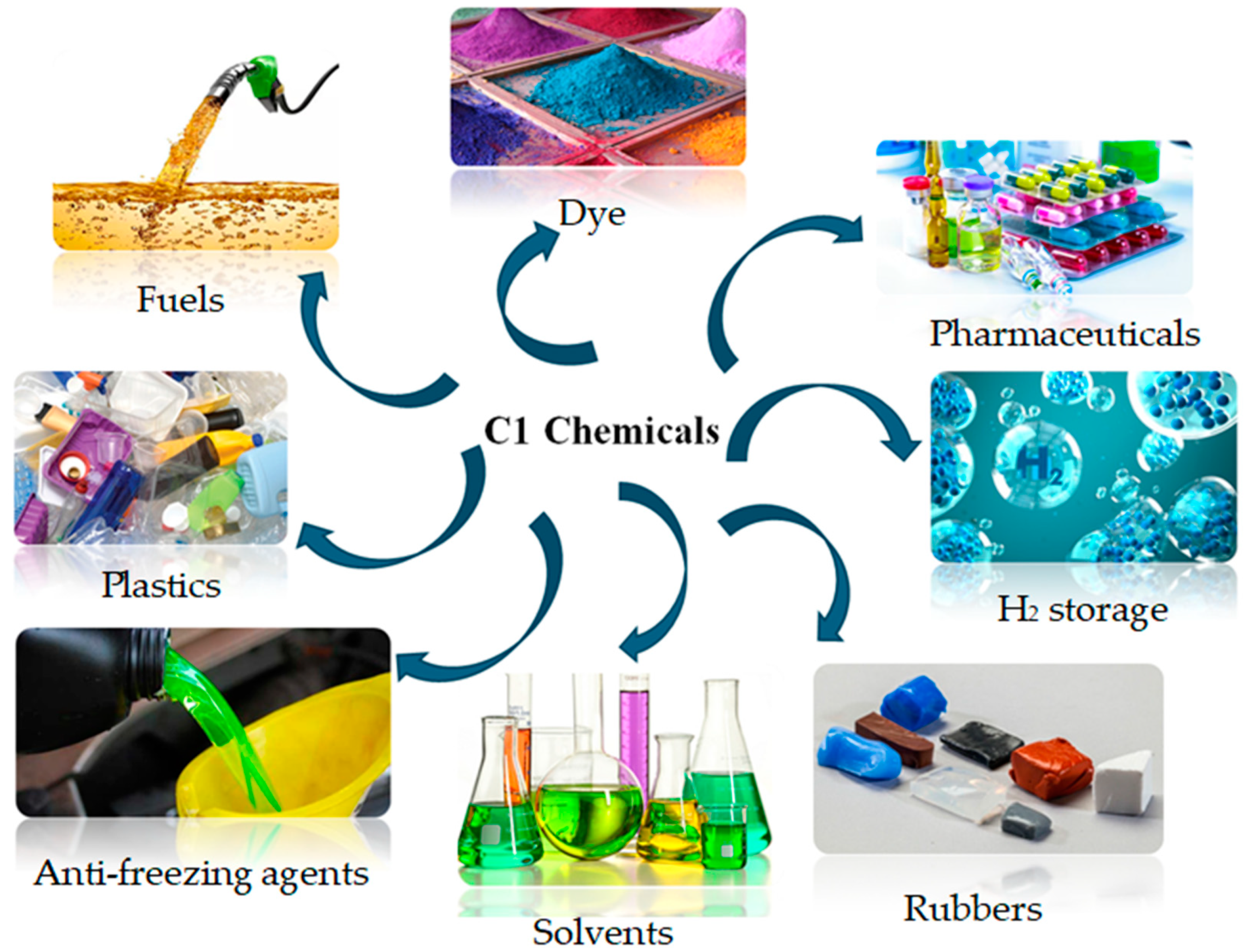


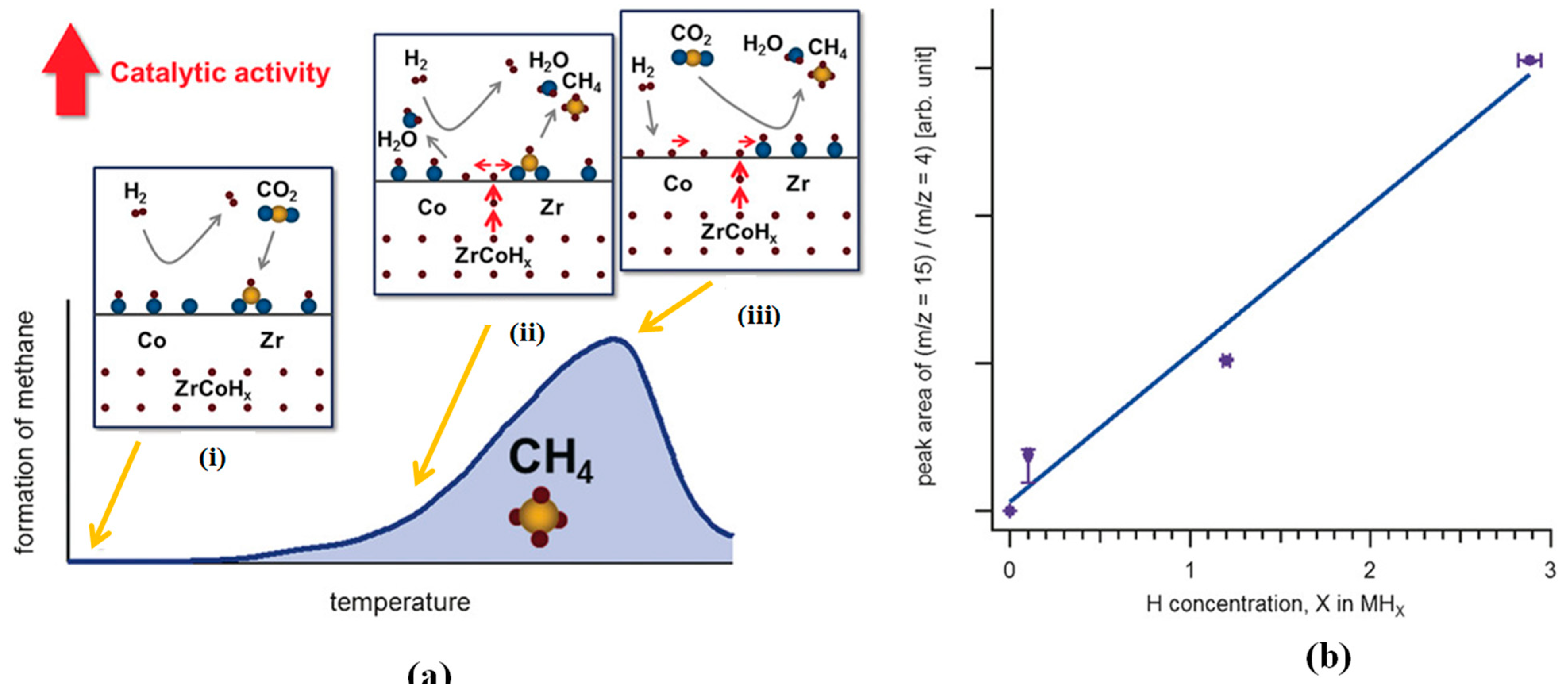
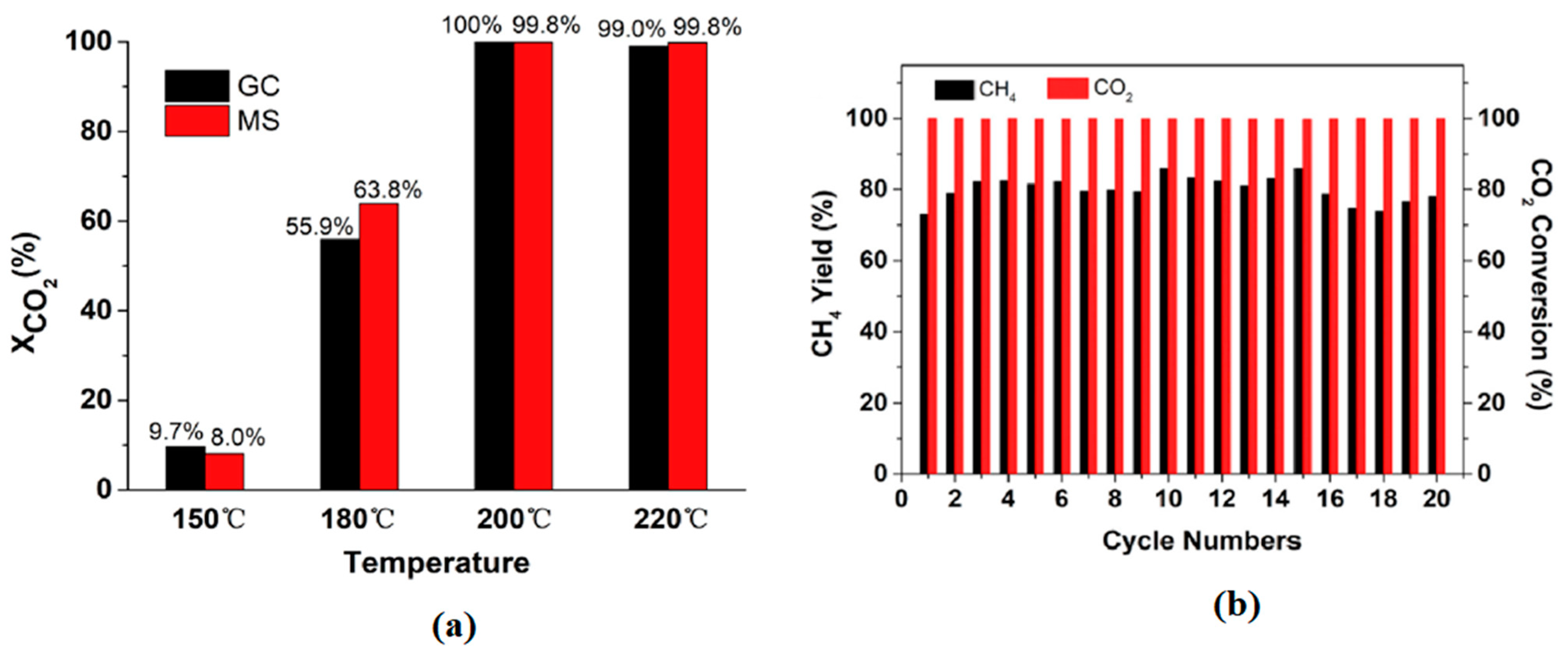

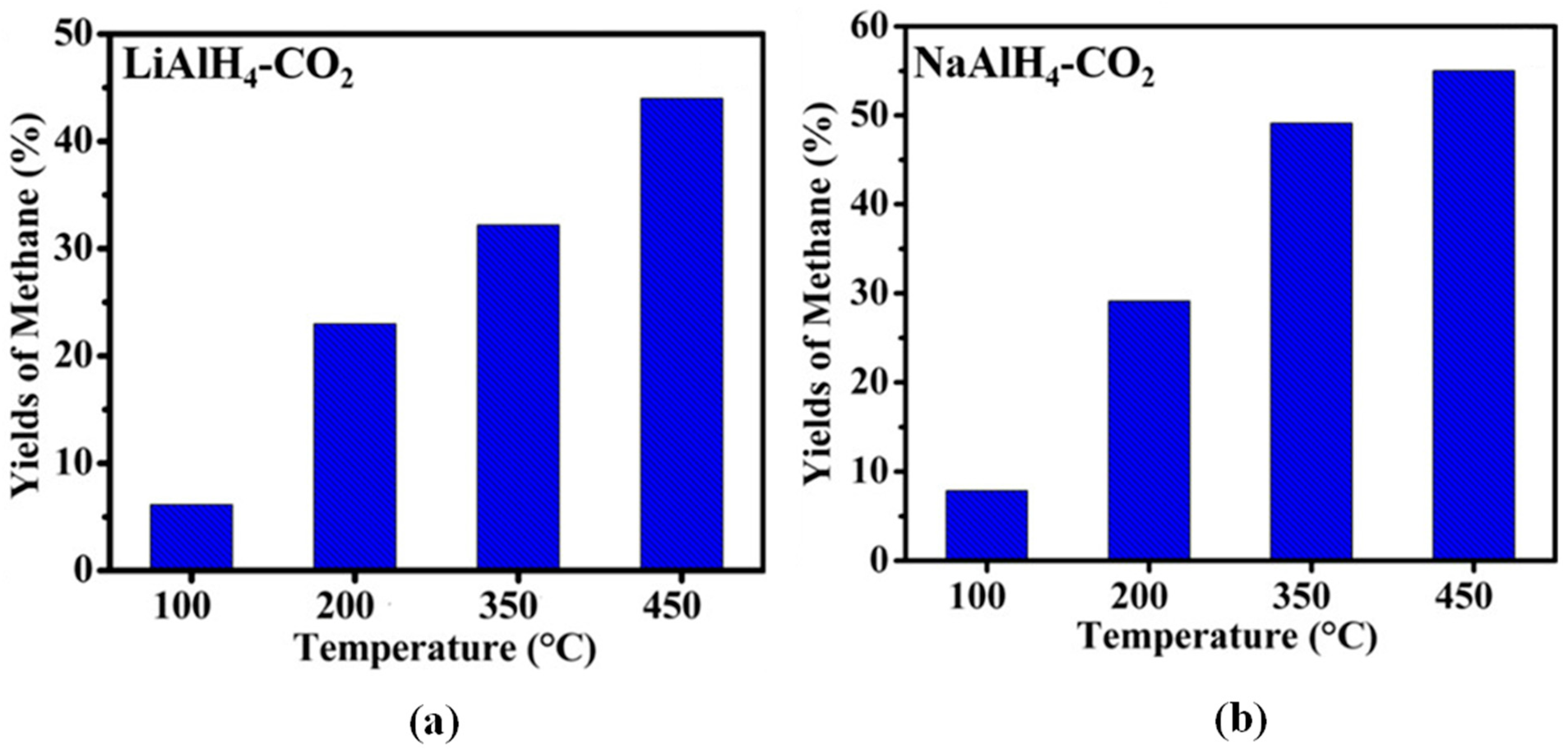

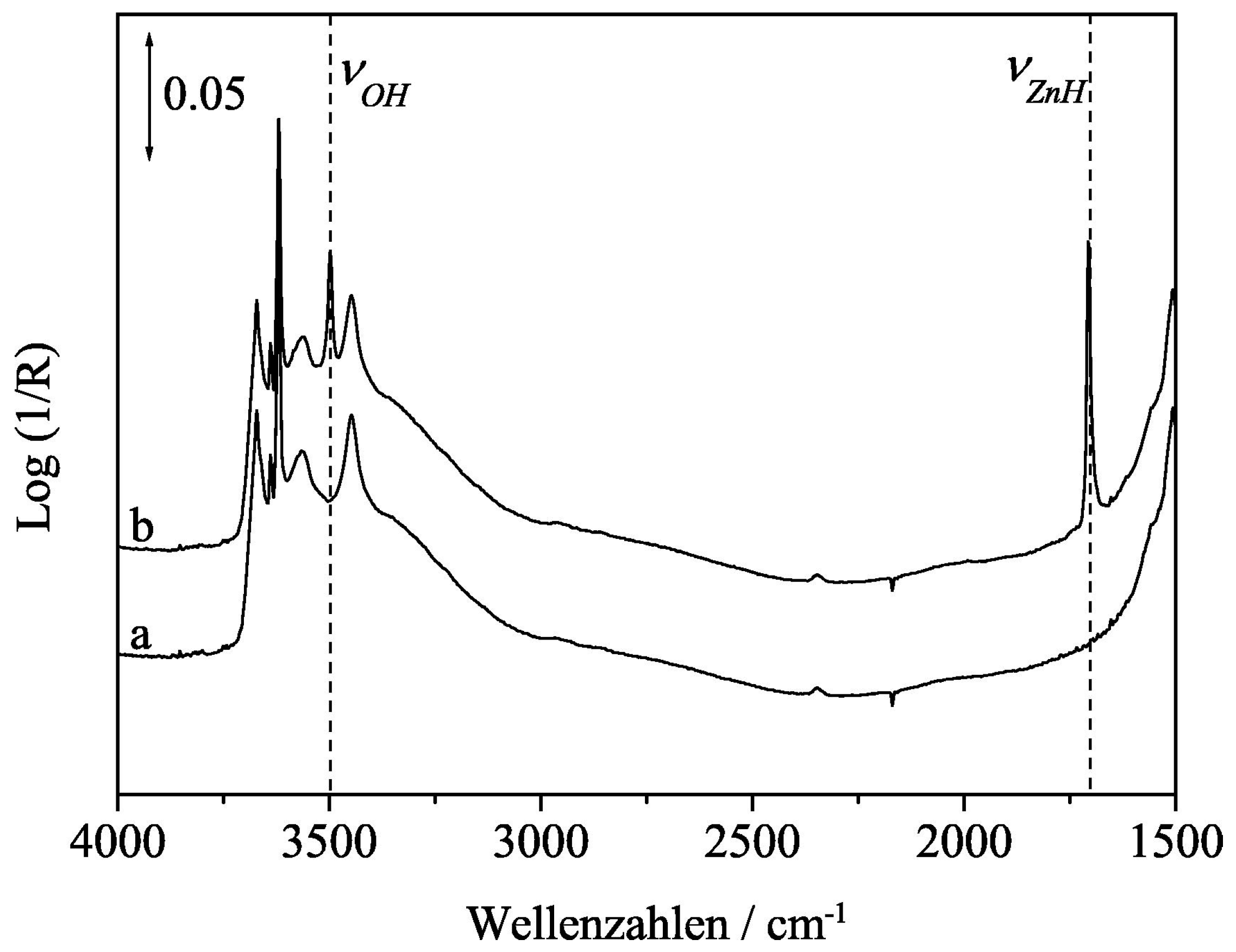
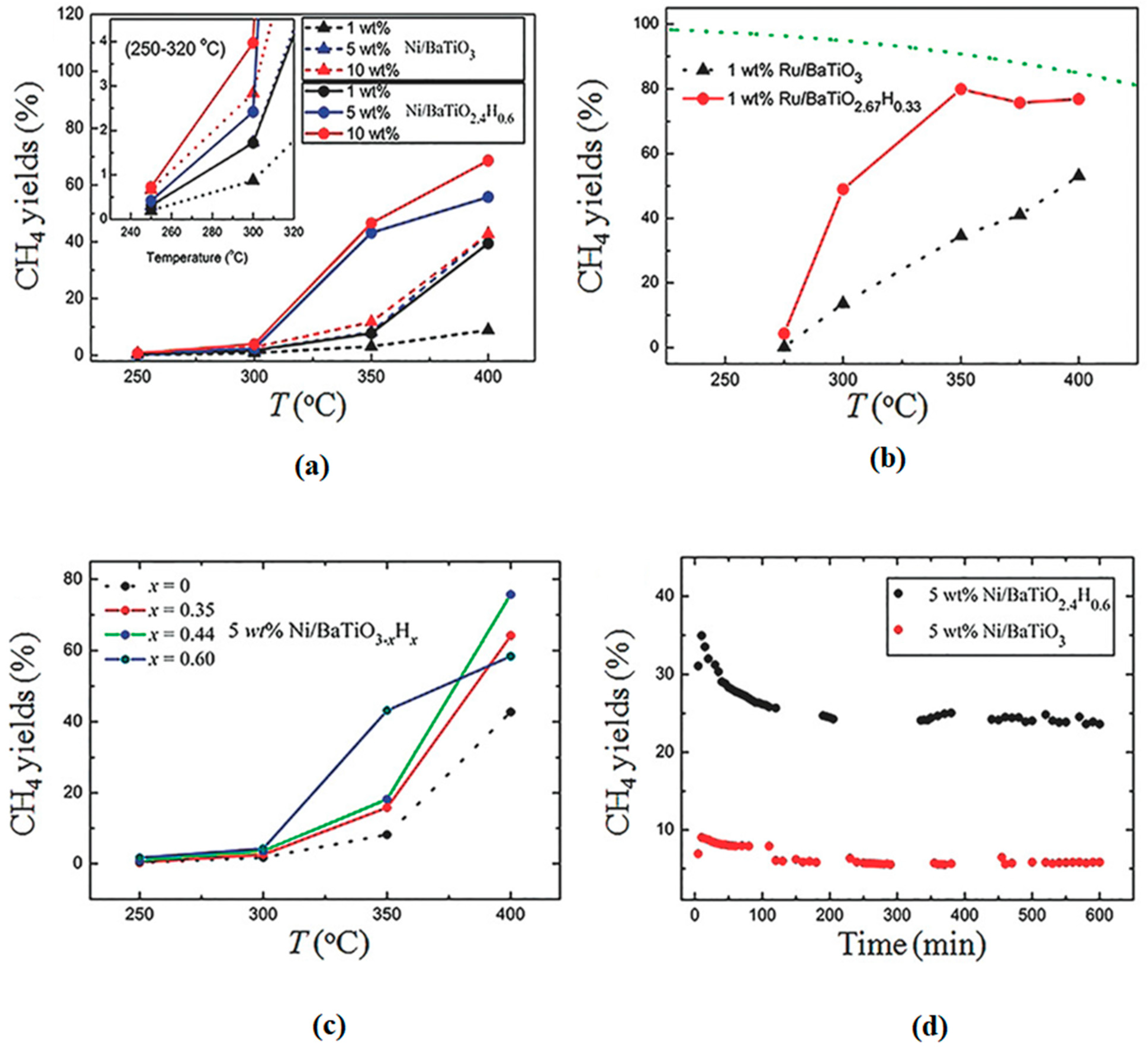
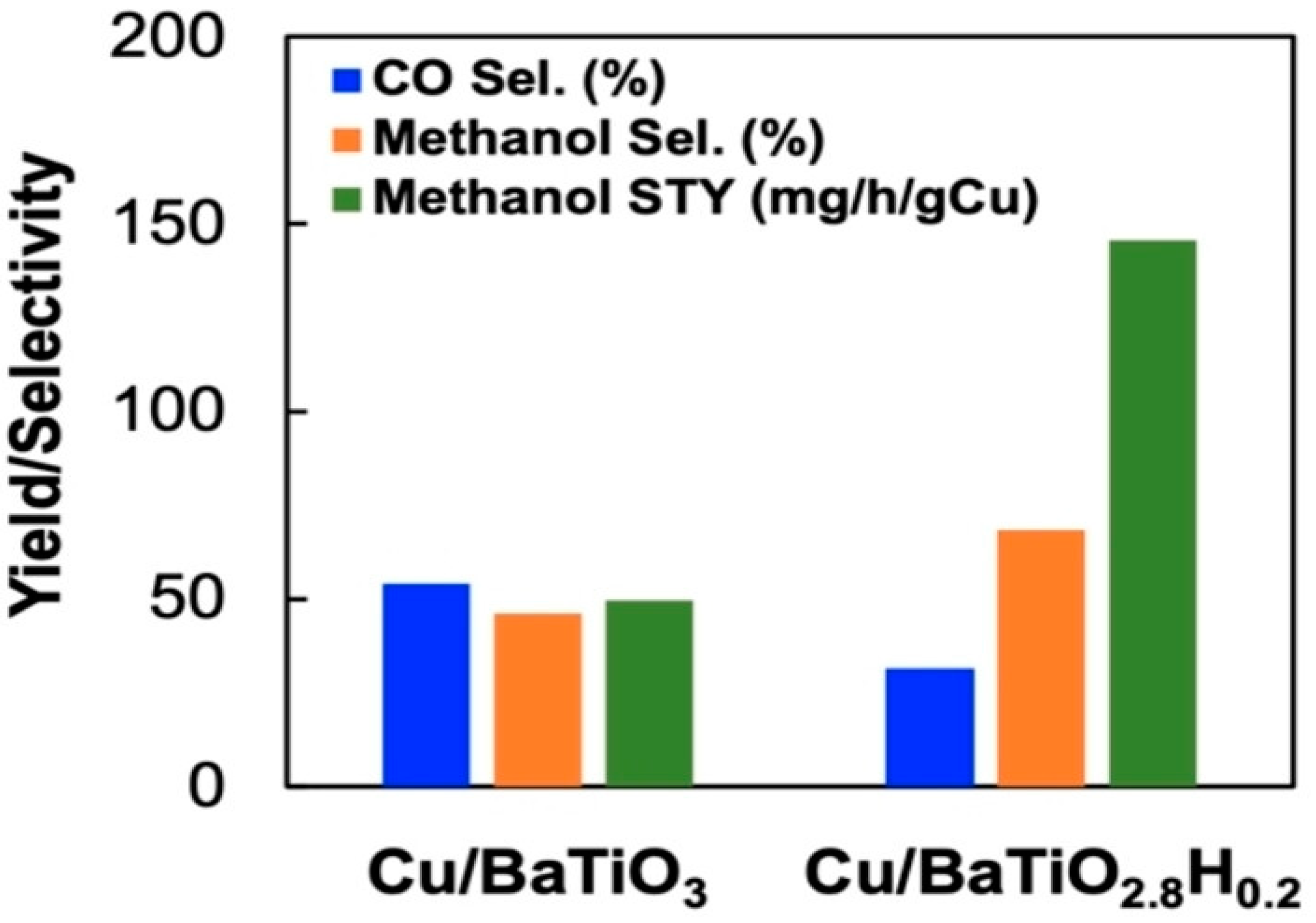
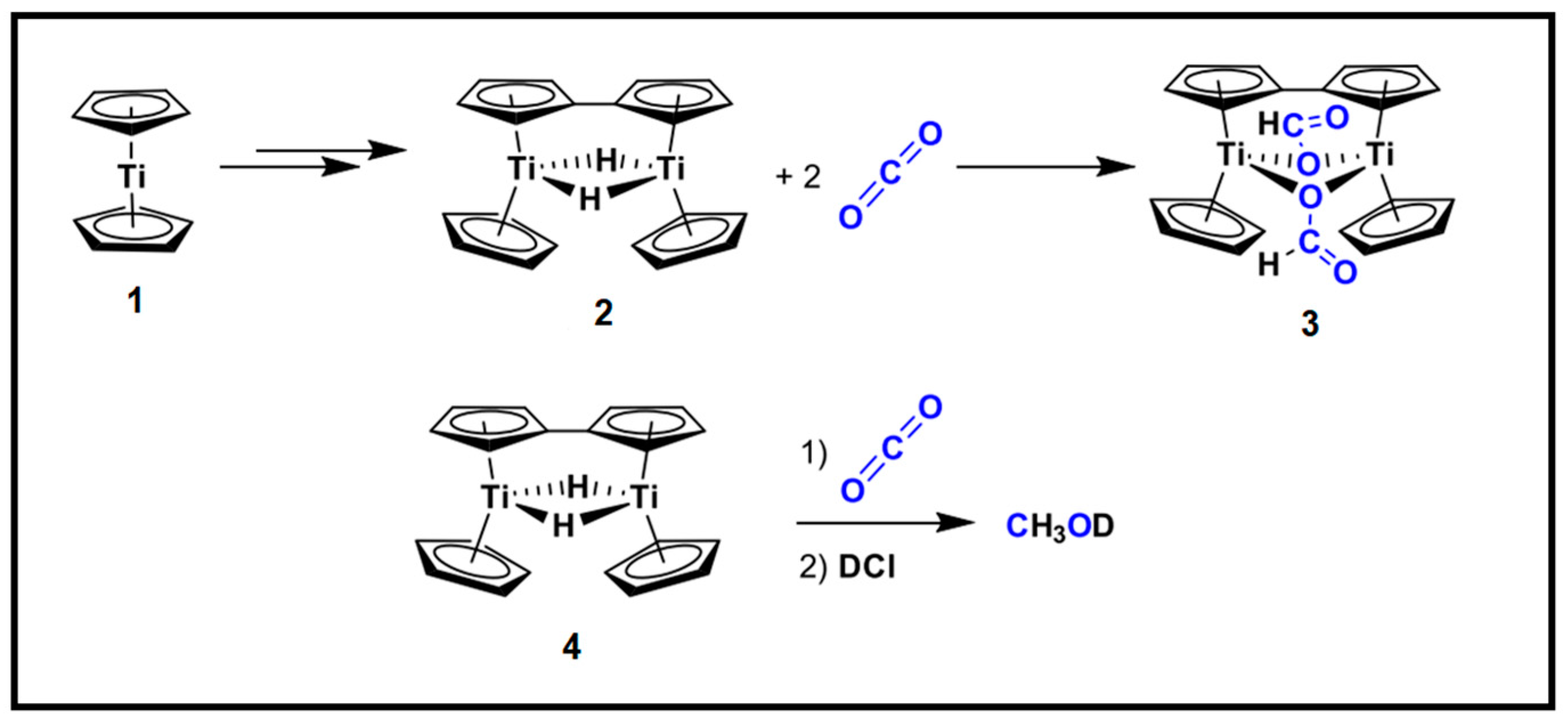
| Category | Metal Hydride |
|---|---|
| Ionic hydrides | LiH, NaH, BaH2, CaH2, MgH2 |
| Interstitial hydrides | YH3, PdHx, FeTiH1.7, LaNi5H6, |
| Covalent hydrides | AlH3, CuH, NH3BH3, BeH2 |
| Complex hydrides | Mg2NiH4, LiAlH4, NaBH4, BaReH9 |
| High-pressure metal hydrides | Li6NbH11, Li5MoH11, Mg3CrH8 |
| Category | Metal hydride | Drawbacks | Benefits |
|---|---|---|---|
| Binary | MHx, NaH, LiH, MgH2, CaH2 |
|
|
| Intermetallic | ABxHy TiMn2Hx, TiFeHx, LaNi5Hx |
|
|
| Complex | MEHx NaAlH4, LiBH4, LiNH2, Mg(BH4)2, Mg(NH2)2, Mg(AlH4)2 |
|
|
| Type of Catalyst | Hydriding Conditions | Reaction Conditions | XCO2[%] | CH4 Y [%] | CH4 [g/kg.h] | CH4 S [%] | Ref |
|---|---|---|---|---|---|---|---|
| Mg2NiH4 | T = 250 °C, P =2 MPa H2, t = 48 h Magnetron Sputtering | TOS = 6.5 h, P = 10 bar, T= 330–600 °C, (H2:CO2 = 6:1), WHSV = 1200 mL/gcat.h | 100 | 80 | [52] | ||
| Mg2NiH4 | T = 250 °C, P =2 MPa H2, t = 48 h Magnetron Sputtering | TOS = 6.5 h, P = 1 bar, T = 330–600 °C, (H2:CO2 = 6:1), WHSV = 1200 mL/gcat.h | 100 | 75 | [52] | ||
| MgH2-5wt.%Ni-5wt.% CNT | Millingb, t = 5 h, 500 rpm, 53:1 Ball to powder | TOS = 48 h, T = 350 °C, (MgH2:CO2 = 4:1) | 100 | 79 | 70.9 | [53] | |
| Ni-MgO/MgH2 | Millingb, t= 3–15 h, 270 rpm, 47:1 Ball to powder | TOS = 5 h, P = 1 MPa, T = 380 °C, (H2:CO2 = 4:1), WHSV = 9600 mL/gcat.h | 85.2 | 944.6 | 99.5 | [54] | |
| Mg2NiH4 | Millingb, t = 60 h, 500 rpm, 10:1 Ball to powder, P =20 bar H2 | TOS = 5 h, P = 0.12 MPa, T = 400 °C, (H2:CO2 = 4:1) | 100 | 95 | [55] | ||
| LaNi5H5 | Heating, t = 5 h, T = 150 °C, P = 4 MPa H2 | TOS = 400 h, P = 3 MPa, T = 200 °C, (H2:CO2 = 4:1) | 99 | 72 | [56] | ||
| Al-MgH2 | Millingc, t = 5 h, 270 rpm, T = amb, P = 1 MPa H2 | TOS = 2 h, P = 1 MPa, T = 320 °C, (H2:CO2 = 5:1), WHSV = 4800 mL/gcat.h | 27.1 | 88.4 | [57] | ||
| MgH2/CuxO | Millingc, t = 3 h, 270 rpm, T = amb, P = 1 MPa H2 | TOS = 2 h, P = 1 MPa, T = 300 °C, (H2:CO2 = 10:1), WHSV = 2400 mL/gcat.h | 20.7 | 90 | [50] | ||
| MgH2-10wt% Co | Millingb, t = 5 h, 500 rpm, 53:1 Ball to powder | TOS = 48 h, T = 350 °C, (MgH2:CO2 = 4:1) | 78 | [58] | |||
| Mg2FeH6 | Millingb, t = 5 h, 500 rpm, P = 1 MPa H2 10:1 Ball to powder | TOS = 5 h, T = 400 °C, (H2:CO2 = 4:1) | 100 | a | [59] | ||
| Mg2NiH4 | Millingb, t = 5 h, 500 rpm, P = 1 MPa H2, 10:1 Ball to powder | TOS = 10 h, T = 400 °C, (H2:CO2 = 4:1) | 100 | a | [59] | ||
| XH2 (X= Mg or Ca) | Millingb, t =48 h, 90:1 Ball to powder | TOS = 48 h, P = 0.25 MPa, T = 450 °C, (XH2:CO2 = 2:1) | >80 | [60] |
| MH-DUT-5 | k (s−1) | G°Ads (kcal/mol) | G°Prod (kcal/mol) |
|---|---|---|---|
| MnH-DUT-5 | 5.82 × 10−3 | −0.8 | −3.3 |
| FeH-DUT-5 | 5.89 × 10−2 | 1.4 | −2.0 |
| CoH-DUT-5 | 7.58 × 10−7 | 0.9 | −3.3 |
| NiH-DUT-5 | 5.29 × 101 | −1.1 | −6.7 |
| CuH-DUT-5 | 1.08 × 10−3 | 0.7 | 2.5 |
Disclaimer/Publisher’s Note: The statements, opinions and data contained in all publications are solely those of the individual author(s) and contributor(s) and not of MDPI and/or the editor(s). MDPI and/or the editor(s) disclaim responsibility for any injury to people or property resulting from any ideas, methods, instructions or products referred to in the content. |
© 2025 by the authors. Licensee MDPI, Basel, Switzerland. This article is an open access article distributed under the terms and conditions of the Creative Commons Attribution (CC BY) license (https://creativecommons.org/licenses/by/4.0/).
Share and Cite
Mafokoane, M.A.; Ou, X.; Musyoka, N.M.; Chang, F. Carbon Dioxide Activation and Hydrogenation into Value-Added C1 Chemicals over Metal Hydride Catalysts. Catalysts 2025, 15, 424. https://doi.org/10.3390/catal15050424
Mafokoane MA, Ou X, Musyoka NM, Chang F. Carbon Dioxide Activation and Hydrogenation into Value-Added C1 Chemicals over Metal Hydride Catalysts. Catalysts. 2025; 15(5):424. https://doi.org/10.3390/catal15050424
Chicago/Turabian StyleMafokoane, Malesela A., Xiaoxia Ou, Nicholas M. Musyoka, and Fei Chang. 2025. "Carbon Dioxide Activation and Hydrogenation into Value-Added C1 Chemicals over Metal Hydride Catalysts" Catalysts 15, no. 5: 424. https://doi.org/10.3390/catal15050424
APA StyleMafokoane, M. A., Ou, X., Musyoka, N. M., & Chang, F. (2025). Carbon Dioxide Activation and Hydrogenation into Value-Added C1 Chemicals over Metal Hydride Catalysts. Catalysts, 15(5), 424. https://doi.org/10.3390/catal15050424








